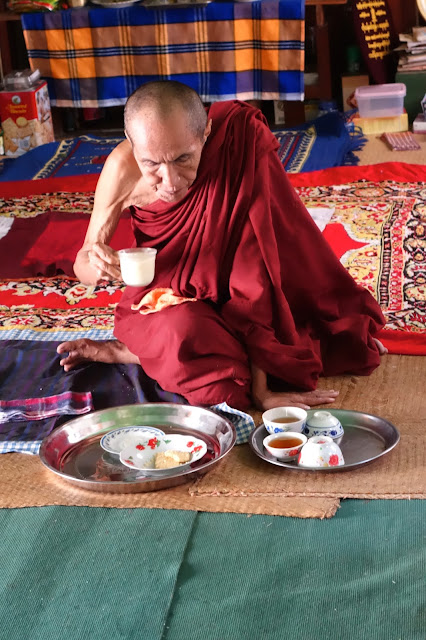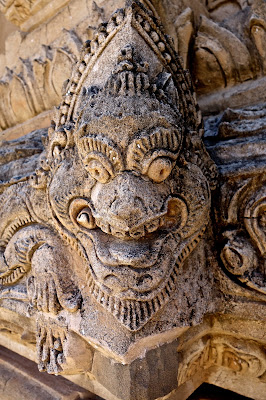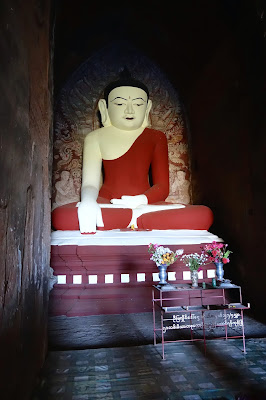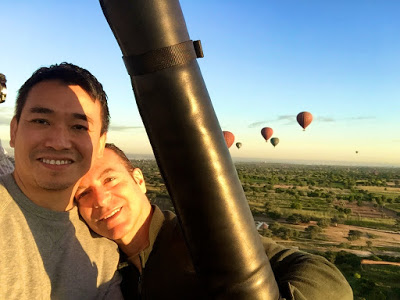
My Trip to Burma: Bagan Part 2 – Balloons over Bagan, Pagodas and Monasteries, and Sunset on the Ayeyarwaddy River.
First the balloon is filled with air. Then the air is heated. Hot air rises, so this causes the balloon to start to go vertical.
The green and yellow balloons were other companies. I much preferred the saffron color of the Balloons Over Bagan.
It was fantastic. Perfect weather, beautiful sunrise.
As we landed, we were immediately met by two little boys who were trying to sell us souvenirs. I wouldn’t call them souvenirs, actually. They were drawings that they had made of the balloons. The kids were adorable. I didn’t buy their drawings, but I did give them some money.
The market was pretty lively, selling all kinds of interesting produce, spices, and sundries.
A very friendly (but aggressive) saleswoman tried very hard to get Mark to buy a longyi, going as far as to throw it over his head and wrap it around his waist, but he declined.
After the market, we headed to more pagodas. This time, we were exploring some later ones, like 12th and 13th century. Our first stop was Nandamannya.
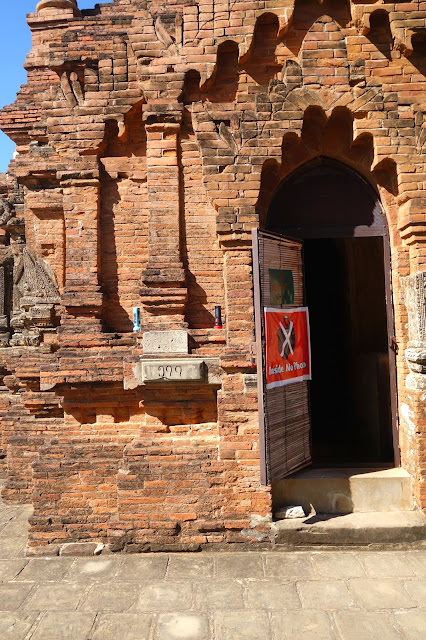 Nandamannya Pagoda was built in the mid-13th century. It is a single-chambered temple has very fine frescoes and a ruined, seated Buddha image. The murals’ similarity with those at Payathonzu has led some art historians to suggest they were painted by the same hand. We passed by Payathonzu, but didn’t go inside, so I wasn’t able to compare.
Nandamannya Pagoda was built in the mid-13th century. It is a single-chambered temple has very fine frescoes and a ruined, seated Buddha image. The murals’ similarity with those at Payathonzu has led some art historians to suggest they were painted by the same hand. We passed by Payathonzu, but didn’t go inside, so I wasn’t able to compare.  Normally when I see a sign like that, I sneak a few photos regardless, but this place was too small, and I couldn’t pull it off. Sorry. You’ll have to be content with viewing this cute little dog that was sleeping outside the temple.
Normally when I see a sign like that, I sneak a few photos regardless, but this place was too small, and I couldn’t pull it off. Sorry. You’ll have to be content with viewing this cute little dog that was sleeping outside the temple. The cave part was pretty interesting. Very serene. You can see how austerely they live.
The cave part was pretty interesting. Very serene. You can see how austerely they live.
 There were little alcoves along the cave walls. They were outfitted with a small platform for meditation, as Mark is demonstrating.
There were little alcoves along the cave walls. They were outfitted with a small platform for meditation, as Mark is demonstrating.
After the monastery, we drove a little bit to Thambula Paya.
Like the Nandamannya, this is a 13th century temple, and it is similar in appearance.
 The coolest thing about this place is that it was locked. Our guide had the key, though. He let us in, and again, we had the entire place to ourselves.
The coolest thing about this place is that it was locked. Our guide had the key, though. He let us in, and again, we had the entire place to ourselves.
 This temple is home to a superb collection of murals. The ceilings were high and there was enough light to be able to see them without the aid of a flashlight.
This temple is home to a superb collection of murals. The ceilings were high and there was enough light to be able to see them without the aid of a flashlight.
 Some dark corners did need a little extra light.
Some dark corners did need a little extra light.
 Densely detailed paintings covered nearly every surface.
Densely detailed paintings covered nearly every surface.
The most impressive were several intricately painted inscriptions. These were very well preserved and looked like they were painted recently, and not hundreds of years ago.
And of course, there were Buddha images everywhere.
I’ve mentioned Payathonzu a few times in this post. We never did go into Payathonzu, but we did drive past it. I thought I’d elaborate on it a bit, because it’s a really unique temple in that it comprises three identical small tower-topped shrines joined together in a line and connected by a single corridor. The murals inside are supposed to be quite interesting, and I kinda wish we had stopped here. In any event, note the three identical towers. (Sorry… a tree is blocking the third one.)
 Our last temple before lunch is called Tayok Pye. It was built by King Narathihapate, who reigned from 1256 to 1287. It was in 1287 that the Mongols invaded. Fearing for his life, he fled down the Ayeyarwaddy River with his court, earning him the name ‘He Who Fled from the Chinese’. That’s what Tayok Pye means. On his flight out of Bagan, he was killed by his own son, Thiha Thu. Thih Thu was, in turn, killed by his half-brother Kyaw Swar who then took the throne of Bagan with the support of Kublai Khan. He was removed within a year and was replaced by his son, Saw Hnit. Oy, such family drama!
Our last temple before lunch is called Tayok Pye. It was built by King Narathihapate, who reigned from 1256 to 1287. It was in 1287 that the Mongols invaded. Fearing for his life, he fled down the Ayeyarwaddy River with his court, earning him the name ‘He Who Fled from the Chinese’. That’s what Tayok Pye means. On his flight out of Bagan, he was killed by his own son, Thiha Thu. Thih Thu was, in turn, killed by his half-brother Kyaw Swar who then took the throne of Bagan with the support of Kublai Khan. He was removed within a year and was replaced by his son, Saw Hnit. Oy, such family drama!
Anyway…. you drive up, go through this little gate, and the temple awaits you a few hundred yards away.
The temple is known for its ornate stucco work. Check it out!
There was also some nicely preserved green glazed tiles on the exterior.
 And, as usual, the place was replete with Buddha images.
And, as usual, the place was replete with Buddha images.
Time for lunch. We told our guide we wanted authentic Burmese food. He suggested a nearby place.
I think “authentic” or “genuine” would have been a better word than “typical”. Funny.
You get soup, a salad, a main dish with your choice of meat, rice, and fruit for dessert, all for the hefty price of 4000 kyat. That’s about $3.50. Amazing.
Sadly, the food was gross, in my opinion. The soup was nasty. Very fishy and salty. The bitter melon was bad. The side dishes were also weird tasting. The chicken wasn’t boneless, as I prefer. It was a scrawny little chicken leg with the skin. Oh well. The pumpkin curry was really good.
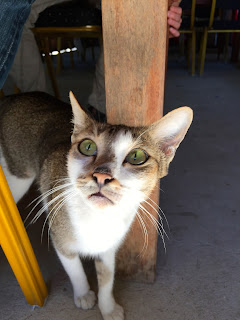 There was, however, a nice cat roaming the restaurant looking for food. Of course, I obliged.
There was, however, a nice cat roaming the restaurant looking for food. Of course, I obliged.
After lunch, we went to Bagan’s largest temple, the colossal Dhammayangyi Pahto. It’s not just the sheer size of the place that makes it recognizable, but also the distinctive outline in that it lacks an upper storey, instead having a series of no fewer than six steep terraces rather than the usual three placed on top of the shrine, giving it that ziggurat type appearance (like a terraced pyramid)
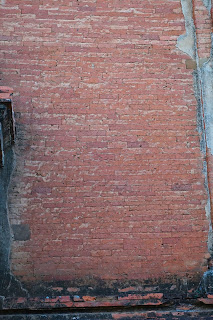 The exterior is known for its superb masonry. Narathu ordered that the bricks be fitted together so tightly that not even a needle could be inserted between them. Any workman who failed to achieve this necessary close fit got his hands lopped off, again showing what a nice guy this Narathu dude was.
The exterior is known for its superb masonry. Narathu ordered that the bricks be fitted together so tightly that not even a needle could be inserted between them. Any workman who failed to achieve this necessary close fit got his hands lopped off, again showing what a nice guy this Narathu dude was. 
 The stark interior has only a few murals of any interest. Otherwise, the interior is pretty bare and melancholy, with high corridors.
The stark interior has only a few murals of any interest. Otherwise, the interior is pretty bare and melancholy, with high corridors.After the Dhammayangyi, we headed to the jetty for our sunset cruise on the Ayeyarwaddy River. On the way, we passed by the Tharabar Gate. It’s the only one of the Old Bagan’s twelve former gateways to survive. It is flanked by a pair of brick-walled shrines dedicated to the two Mahagiri nat spirits, popularly known as Maung Tinde (“Mr. Handsome”) whose images stands in a niche on the left-hand side of the gate, and his sister Shwemyethna (“Golden Face”) opposite. You’ll hear more about Mr. Handsome and Golden Face tomorrow on our trip to Mount Popa.
We headed back to the hotel for an hour or two to rest, before embarking on a little boat ride. When we got back to the hotel, our luggage was waiting for us! Myint had made some calls, at my request, to track down the luggage, and it was put on a flight from Rangoon to Bagan. Our driver went to the Bagan airport to pick it up and bring it back to our hotel. That’s what I call service. Another reason to use www.mrmyanmartravel.com if you’re thinking of going to Burma.
I have no problem saying no repeatedly, but Mark gets worn down, and the moment he shows any signs of wavering, they pounce. We said no, but rather than accept this, they all said, “maybe later?” This seemed safe enough, so we said sure, maybe later. Mark ascertained their names: Dudu, Mumu, and Bobo.
Once again, the weather was perfect, and the boat ride was peaceful and relaxing. That’s me on deck with our guide, Myint.
The sun began to set. Boats on the water, silhouetted against the hill as the sun dipped below the horizon made for a perfect afternoon.
As we headed back to shore, we passed by Bupaya, the “Gourd Stupa”, high atop a bluff overlooking the water. It’s Old Bagan’s most popular place of local worship. The major feature is the unusual gilded stupa, raised above the water on a crenellated white terrace, with steps leading down to the river below. The stupa’s distinctive bulbous, gourd-shaped outline is typical of early Pyu architecture. It’s a favorite sunset viewing spot, and you could see people still lingering up there post-sunset.
We ended our night at Gawdawpalin, one of Bagan’s largest and most ethereal temples. It is of the gu or “hollow” type, with porticoes on four sides and a vaulted inner corridor. This is the skinny supermodel of all the monuments in Old Bagan.
It was started under King Narapatisithu, completed by his son Htilominlo, and then badly damaged in the 1975 earthquake, although it’s been fixed up. The slender spire reaches a height of 55m, which is one of the tallest in Bagan. The exterior has fine stuccowork, but the interior is kinda plain.
You’ve got your standard big Buddha in here, but otherwise, not much to see. (I guess after seeing so many striking temples and phenomenal Buddhas, a huge gold Buddha like this is now just a dime a dozen. How jaded!)
Tomorrow, the amazing Mount Popa!










